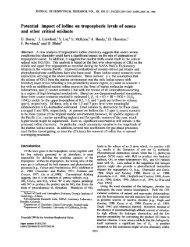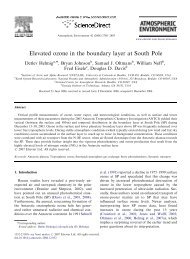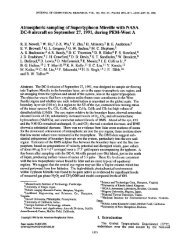A Study of the Chemical Degradation of ClONO2 in the ...
A Study of the Chemical Degradation of ClONO2 in the ...
A Study of the Chemical Degradation of ClONO2 in the ...
Create successful ePaper yourself
Turn your PDF publications into a flip-book with our unique Google optimized e-Paper software.
een negligible. Support<strong>in</strong>g evidence <strong>of</strong> this<br />
po<strong>in</strong>t <strong>of</strong> view was provided by carry<strong>in</strong>g out sever-<br />
al flash energy variation experiments, typically<br />
a factor <strong>of</strong> four, and f<strong>in</strong>d<strong>in</strong>g that <strong>the</strong> pseudo-<br />
first order rate constants kl and k were<br />
<strong>in</strong>dependent <strong>of</strong> <strong>the</strong> flash <strong>in</strong>tensity. S<strong>in</strong>ce any<br />
secondary reaction would necessarily <strong>in</strong>volve<br />
ei<strong>the</strong>r <strong>the</strong> phot<strong>of</strong>ragments <strong>of</strong> C1ONO 2 or products<br />
<strong>of</strong> Reactions (1) and (2), <strong>the</strong> decay rate <strong>of</strong><br />
O(3p) or OH would be proportional to <strong>the</strong> square<br />
<strong>of</strong> <strong>the</strong> flash energy. As noted above, no such<br />
observation was recorded.<br />
Table I lists <strong>the</strong> relative chemical degradation<br />
rates (R i and R2) as a function <strong>of</strong> altitude<br />
result<strong>in</strong>g from Reactions (1) and (2). The<br />
destruction <strong>of</strong> C1ONO 2 through its reaction with<br />
C1(2p3/2) has not been <strong>in</strong>cluded <strong>in</strong> <strong>the</strong> quoted<br />
total chemical degradation rate because: (1)<br />
Ravishankara et al.: <strong>Chemical</strong> <strong>Degradation</strong> 9<br />
<strong>the</strong> rate constant for <strong>the</strong> reaction <strong>of</strong> C1(2P3s/2)<br />
with C1ONO 2 is only 1 x 10-1cm molecule-! -!<br />
accord<strong>in</strong>g to prelim<strong>in</strong>ary results obta<strong>in</strong>ed <strong>in</strong><br />
ourslaboratory, and (2) <strong>the</strong> concentration <strong>of</strong><br />
Ci(P3/2) at mid-stratospheric altitudes is very<br />
much lower than that <strong>of</strong> ei<strong>the</strong>r OH or O(P).<br />
Along with <strong>the</strong> chemical degradation rates, we<br />
have listed <strong>the</strong> photochemical destruction rate<br />
(J), as well as <strong>the</strong> total degradation rate <strong>of</strong><br />
C1ONO 2 (R! + R 2 + J). As can be seen from <strong>the</strong><br />
Table, chemical processes (1) and (2) contribute<br />
less than 10% to <strong>the</strong> total rate <strong>of</strong> C1ONO 2<br />
destruction at altitudes less than 30 Km. S<strong>in</strong>ce<br />
th concentration <strong>of</strong> C1ONO 2 is calculated to be<br />
near its maximum around 25 Km and drops <strong>of</strong>f<br />
very significantly at higher altitudes, it must<br />
be concluded that <strong>the</strong> photochemical decomposition<br />
<strong>of</strong> C1ONO 2 <strong>in</strong> <strong>the</strong> stratosphere is by far<br />
<strong>the</strong> most important degradation path for this<br />
molecule. It is possible that <strong>the</strong> contribution<br />
<strong>of</strong> <strong>the</strong> chemical degradation rate to <strong>the</strong> total<br />
destruction <strong>of</strong> C1ONO 2 could be different from<br />
our calculations s<strong>in</strong>ce, (a) <strong>the</strong> concentration <strong>of</strong><br />
OH radicals <strong>in</strong> <strong>the</strong> stratosphere is still not well<br />
known, and (b) radicals o<strong>the</strong>r than OH, O(P), or<br />
C!(2p/2) could also degrade C1ONO2 to a signifi-<br />
cant degree. However, we do not expect our basic<br />
conclusion, that photolysis is <strong>the</strong> dom<strong>in</strong>ant mode,<br />
to change.<br />
Acknowledgements. D. D. Davis would like to<br />
acknowledge th f<strong>in</strong>ancial support <strong>of</strong> this work by<br />
<strong>the</strong> National Aeronautics and Space Adm<strong>in</strong>istration.<br />
G. Tesi was on sabbatical leave from <strong>the</strong> National<br />
Science Foundation dur<strong>in</strong>g this project.<br />
References<br />
Chang, J. and D. Wuebbles, "An Analysis <strong>of</strong><br />
Coupled <strong>Chemical</strong> K<strong>in</strong>etics and Transport Models<br />
<strong>of</strong> <strong>the</strong> Stratosphere", Intnl. Ozone Symposium,<br />
Dresden, E. Germany, August 1976.<br />
Crutzen, P.J., Review <strong>of</strong> Atmospheric Chlor<strong>in</strong>e<br />
Chemistry, Intnl. Ozone Symposium, Dresden,<br />
E. Germany, August 1976.<br />
Davis, D.D., R.E. Huie, J.T. Herron, M.J. Kurylo,<br />
and W. Braun, "Absolute Rate Constant for <strong>the</strong><br />
Reaction <strong>of</strong> Atomic Olygen with Ethylene Over<br />
<strong>the</strong> Temperature Range 232-500 K", J. Chem.<br />
Phys., 56, p.4868 (1972).<br />
Davis, D.D., J. Herron, and J. Huie, "Absolute<br />
Rate Constant for <strong>the</strong> Reaction O(3P) + NO 2<br />
--NO + 02 Over <strong>the</strong> Temperature Range 230-<br />
339 K", J. Chem. Phys., 58, p.530 (1973).<br />
Davis, D.D., S. Fischer, and R. Schiff, "Flash<br />
Photolysis Resonance Fluroescence K<strong>in</strong>etics<br />
<strong>Study</strong>: Temperature Dependence <strong>of</strong> <strong>the</strong> Reactions<br />
OH + CO--+ CO 2 + H, and OH + CH4--H20<br />
J. Chem. Phys., 61, p.2213 (1974).<br />
+ CH 3,<br />
Liu, S.C., T.M. Donahue, R. Cicerone, and W.L.<br />
Chameides, "Effects <strong>of</strong> Water Vapor on <strong>the</strong><br />
Destruction <strong>of</strong> Ozone <strong>in</strong> <strong>the</strong> Stratosphere Perturbed<br />
by C1 x or NOx Pollutants", J. Geophys.<br />
Res., 81, pp.3111-3118 (1976).<br />
McAfee, J. and P.J. Crutzen, Modell<strong>in</strong>g Stratospheric<br />
Photochemistry and K<strong>in</strong>etics, The 12th<br />
Informal Conference on Photochemistry, NBS,<br />
U.S.<br />
1976.<br />
Department <strong>of</strong> Commerce, June 28 - July 1,<br />
Miller, R.H., D.L. Bernitt, and I.C. Hisatsune,<br />
"Infrared Spectra <strong>of</strong> Isotopic Halogen Nitrates<br />
Spectrochimica Acta, 23A, p.223 (1967).<br />
Mol<strong>in</strong>a, M.J., Atmospheric Chemistry <strong>of</strong> Chlor<strong>of</strong>luorocarbons,<br />
The 12th Informal Conference<br />
on Photochemistry, NBS, U.S. Department <strong>of</strong><br />
Commerce, June 28 - July 1, 1976.<br />
(Received November 3, 1976;<br />
accepted November 18, 1976. )






